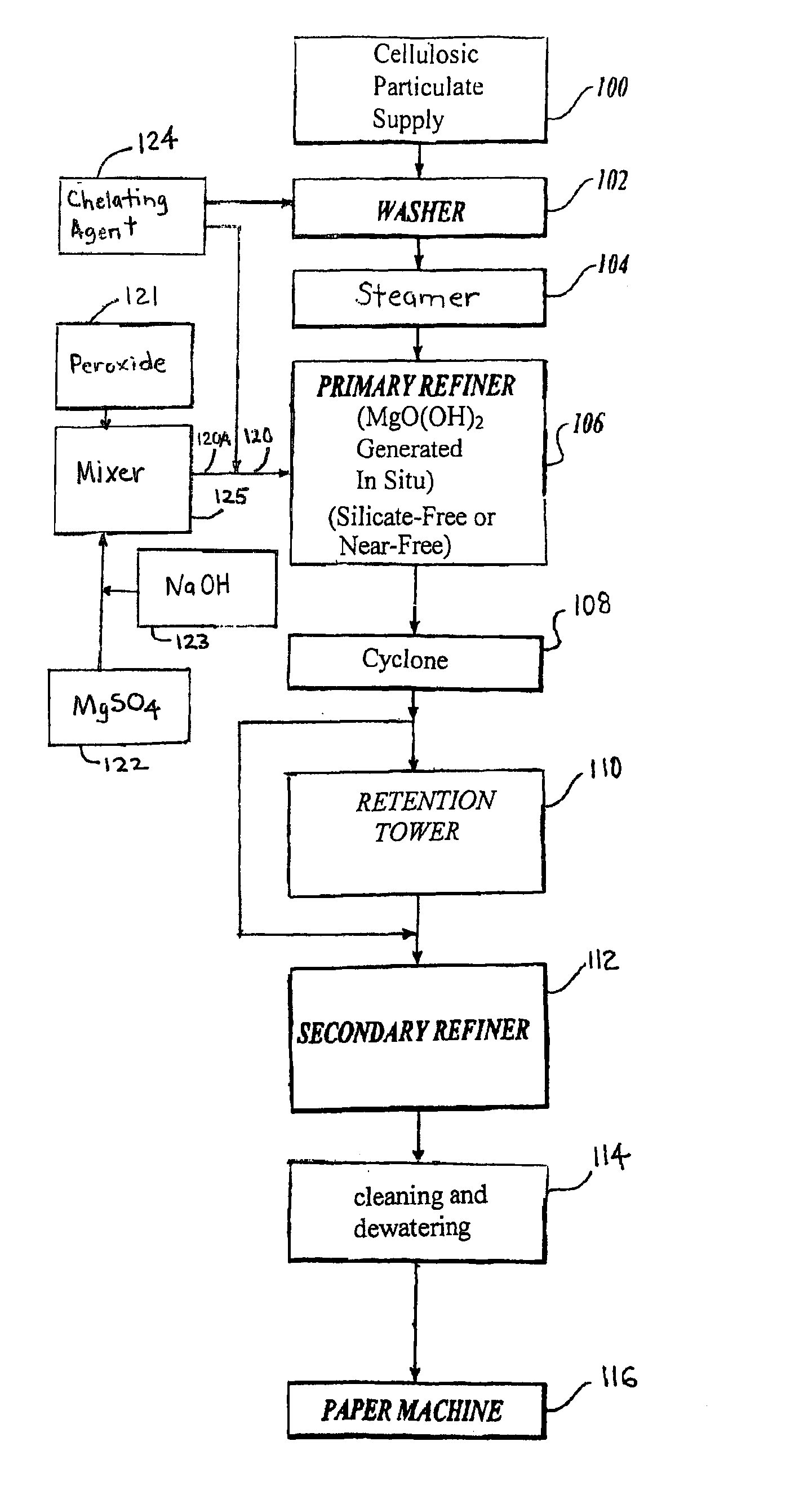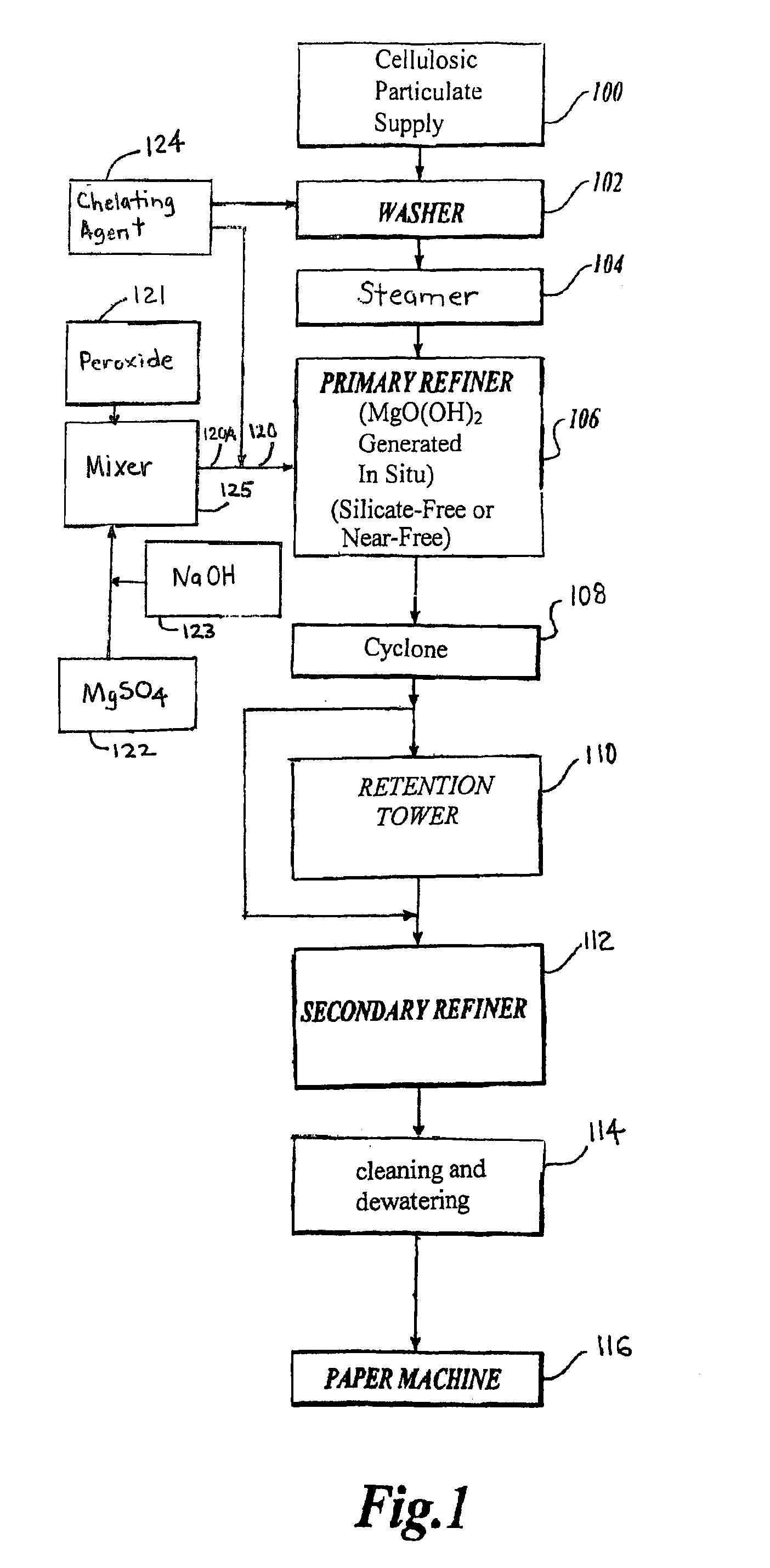Silicate Free Refiner Bleaching
- Summary
- Abstract
- Description
- Claims
- Application Information
AI Technical Summary
Benefits of technology
Problems solved by technology
Method used
Image
Examples
example 1
[0075]A reject refiner was used to conduct a single second stage peroxide bleaching. The refiner equipment used for TMP production included a commercial two (2) stage steel double disk design. The process flow of the bleaching process performed using a reject refiner was as shown in FIG. 3B. The pulp fiber feedstock was hemlock and cottonwood fiber (50 / 50 w / w). A silicate-free bleaching liquor was used that contained peroxide, caustic, chelant, and magnesium sulfate. The composition of the bleaching liquor contained 2% H2O2, 1.5% NaOH, 0.12% MgSO4 (100%), and 0.2% chelating agent, with all amounts given by weight, based on dry weight of the fibers treated in the process. As shown in FIG. 3B, the components of the bleaching liquor were premixed before introduction to the refiner in a manner similar to that such as shown in FIG. 1 and described herein. The fibers and bleaching liquor composition were separately fed into the refiner and combined therein. The refiner temperature was 131...
example 2
[0076]The reject refiner as used in Example 1 again was used to conduct a second stage peroxide bleaching. The pulp fiber again was hemlock and cottonwood fiber (50 / 50 w / w). In this example, the composition of the bleaching liquor was 1.25% H2O2, 2% NaOH, 0.12% MgSO4, and 0.2% chelating agent, with all amounts given by weight based on dry weight of the fibers treated in the process. The fibers and bleaching liquor composition were separately fed into the refiner and combined therein. The refiner temperature was 60-85° C. and the refiner pressure was 0 psig. Total bleaching retention time in the refiner was less than five minutes. The TMP pulp was bleached from 46% ISO to 72% ISO. In another similar run using 1.25% H2O2 in the bleaching liquor, all other materials and conditions substantially the same, the TMP pulp was bleached from 46% ISO to 73.3% ISO.
example 3
[0077]The reject refiner and conditions as used in Example 1 again was used to conduct a second stage peroxide bleaching. The pulp fiber again was hemlock and cottonwood fiber (50 / 50 w / w). In this example, the composition of the bleaching liquor was similar to that indicated for Example 1 with a difference that 0.1% MgSO4 was used initially. The brightness of the bleached TMP pulp initially was determined to be 66.9% ISO. Magnesium sulfate addition was temporarily discontinued while the process continued to run for a time period of about 3.5 hours. The brightness of the bleached TMP dropped from 66.9 to 64.1% ISO in the time period when the magnesium sulfate addition was stopped. When the magnesium sulfate addition was renewed, the brightness of the TMP pulp recovered to 67% ISO.
PUM
| Property | Measurement | Unit |
|---|---|---|
| Temperature | aaaaa | aaaaa |
| Temperature | aaaaa | aaaaa |
| Temperature | aaaaa | aaaaa |
Abstract
Description
Claims
Application Information
 Login to View More
Login to View More - R&D
- Intellectual Property
- Life Sciences
- Materials
- Tech Scout
- Unparalleled Data Quality
- Higher Quality Content
- 60% Fewer Hallucinations
Browse by: Latest US Patents, China's latest patents, Technical Efficacy Thesaurus, Application Domain, Technology Topic, Popular Technical Reports.
© 2025 PatSnap. All rights reserved.Legal|Privacy policy|Modern Slavery Act Transparency Statement|Sitemap|About US| Contact US: help@patsnap.com



